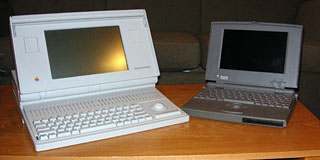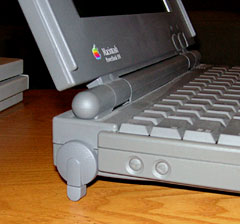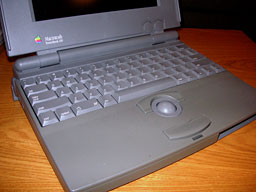You may have heard the original iBook called an
iMac to go. The PowerBook 100 is a Macintosh Portable to go.
This week I'm going to talk about my first PowerBook - and one
of the first PowerBooks ever. The machine is the PowerBook 100.
Some people think the PowerBook 100 was the first PowerBook, but
it was launched in 1991 as the low-end model with the midrange
PowerBook 140 and the high-end PowerBook 170.
The story is that Apple wasn't happy with the 15.8 lb. Macintosh Portable and gave Sony the task
of miniaturizing it. Sony's engineers and designers came up with
the PowerBook 100.

The Mac Portable and PowerBook 100.
Hardware wise, it was nearly identical to the Macintosh
Portable. Both share a 16 MHz 68000 (the fastest 68000 Apple ever
shipped), both had a 40 MB hard drive, both max out at 8 MB of
RAM (well, the backlight model of
the Macintosh Portable does), both have a 640 x 400 black and
white (no shades of gray) screen, and both shipped with
a 1.44 MB floppy drive.
But one thing is different: The 5.1 lb. PowerBook 100 is over 10
pounds lighter!
I bought my PowerBook 100 some time in 2005. I think I paid $30
for it. Unfortunately, when I got it it had a school name engraved
into it, and the floppy drive did as well (but from a different
school).
 It was also missing the port cover (quite common for
most 1xx series books), and one of the fold-out feet was missing,
which is a shame, as the ones on the PowerBook 100 differ from the
rest of the 1xx series (when you fold them out, they also push out
about a quarter of an inch). Quite clever, but this also meant
abandoning the "screwed down from the inside" solution, and they
are merely popped on a hub.
It was also missing the port cover (quite common for
most 1xx series books), and one of the fold-out feet was missing,
which is a shame, as the ones on the PowerBook 100 differ from the
rest of the 1xx series (when you fold them out, they also push out
about a quarter of an inch). Quite clever, but this also meant
abandoning the "screwed down from the inside" solution, and they
are merely popped on a hub.
My machine had the stock 2 MB of RAM, which I soon maxed
out to 8 MB with a 6 MB RAM card.
I am lucky: The school had sprung for the 40 MB hard drive
option (the budget config had a 20 MB drive). It is starting to
show it's age, and is quite loud.
My machine is running System 7.1 - and runs it quite well. I
have mine set up with a bunch of games, and an old version of
Microsoft Word (4.00b) and Excel.
 It's nice and fast, but there are a few other issues
with it: There's a splotch on the screen, which I can minimize by
adjusting the contrast and brightness (which are wheels instead of
sliders, which are used on the rest of the 1xx series). Another
issue is when using the external floppy drive, I get some rasters
on the screen whenever it's reading and writing to the disk, but my
guess is that is just the draw of the power of the floppy drive. It
might not have been noticeable when the machine was new, but I can
see it now.
It's nice and fast, but there are a few other issues
with it: There's a splotch on the screen, which I can minimize by
adjusting the contrast and brightness (which are wheels instead of
sliders, which are used on the rest of the 1xx series). Another
issue is when using the external floppy drive, I get some rasters
on the screen whenever it's reading and writing to the disk, but my
guess is that is just the draw of the power of the floppy drive. It
might not have been noticeable when the machine was new, but I can
see it now.
The PowerBook 100 is the oddball off the 1xx series for many
reasons. The external floppy, the smaller screen (which absolutely
cute with the shape of the bezel), the physically and chemically
different battery (a flat, elongated lead-acid thing), and one
thing most people don't think about: It's easy to work inside. Just
unscrew the screws on the bottom, open up the machine, push the
screen flat, and lift up the keyboard.
The screen and speaker attach to the machine by a single cable
to the motherboard, not a complex and hard to find daughterboard
like the rest of the 1xx series. I can rip this machine apart in
under 15 minutes, which is something unmatched in today's complex
portables.
Another thing I love is the floppy drive, which was repurposed
for the PowerBook Duos. It has a short
cable, but the plug is huge. It is about 2" - not the cable,
just the part that plugs into the computer. It uses a custom HDI-20
port, which is like a shrunken HDI-30 port. It also has a spring
loaded release.
But the part that is real money is the foot (yes, I have a foot
fetish, but only on Macs). It acts like a cover and folds over the
front of the drive, and it flips down to raise the drive up when
it's in use. There is also not a whole lot of casing to the drive,
so it's relatively small. The only issue I have is finding enough
clearance behind the computer to use the plug.
Other little things I love: The backup batteries are three easy
to find CR2430 button cell batteries that go in a little swing out
door on the back (quite clever, as most other 'Books require you to
rip the machine down to the chassis just to get to it; I'm looking
at you, WallStreet).
The interrupt and reset switches are also easy to reach and
press buttons on the side - no flip down of the port door or need
for a paper clip (also a popular iPhone repair tool) required.
 There is no power key, which some people might find
weird, but I don't. You press any key on the keyboard, and it
chimes to life. I use the spacebar, and it feel like I'm waking the
machine up, not turning it on. I also like the smaller trackball,
which fits nicely in my hand - a lot easier than the ones on the
rest of the 1xx series.
There is no power key, which some people might find
weird, but I don't. You press any key on the keyboard, and it
chimes to life. I use the spacebar, and it feel like I'm waking the
machine up, not turning it on. I also like the smaller trackball,
which fits nicely in my hand - a lot easier than the ones on the
rest of the 1xx series.
All in all, the PowerBook 100 is a great little 'Book. If you
can find one, snatch it up. It's very light, and if you're lucky
enough to have one with a working battery (mine is dead, but I have
an external one), these make great little creative writing
machines. Just make sure you have a quiet hard drive, or spin it
down, or make a RAM disk and run off, and you can go for hours.
I would not relate the PowerBook 100 to rest of the PowerBook
1xx series, since it's such an oddball. It's more closely related
to the PowerBook Duo series, and I guess in some ways it was a
precursor of things to come in 1992.

The photos that accompany this article are of Macs
at Low End Mac headquarters; they are not of Leo's PowerBook 100.
As you may notice in the photos, ours is missing a battery.
Further Reading
- The Wonderful PowerBook 100,
Heather Anne Hurd, 2000.12.11
- Hands On: PowerBook 100, Dan
Knight, 2001.03.21
- The Great Old PowerBook 100 and
the Death of the PowerBook Name, Joe Rivera, 2006.03.07
- Field Testing the Carpenter's
PB 100 Fix, Manuel Mejia Jr, 2000.05.09
- Macintosh
PowerBook 100, author identified as "pb5300". "Until the
release of the 100, both Mac and PC portables were heavy, bulky
affairs and were not really any more portable than a Mac SE, Plus
or Classic."
- PowerBook 100
FAQ
- PowerBook
100, Wikipedia


 It was also missing the port cover (quite common for
most 1xx series books), and one of the fold-out feet was missing,
which is a shame, as the ones on the PowerBook 100 differ from the
rest of the 1xx series (when you fold them out, they also push out
about a quarter of an inch). Quite clever, but this also meant
abandoning the "screwed down from the inside" solution, and they
are merely popped on a hub.
It was also missing the port cover (quite common for
most 1xx series books), and one of the fold-out feet was missing,
which is a shame, as the ones on the PowerBook 100 differ from the
rest of the 1xx series (when you fold them out, they also push out
about a quarter of an inch). Quite clever, but this also meant
abandoning the "screwed down from the inside" solution, and they
are merely popped on a hub. It's nice and fast, but there are a few other issues
with it: There's a splotch on the screen, which I can minimize by
adjusting the contrast and brightness (which are wheels instead of
sliders, which are used on the rest of the 1xx series). Another
issue is when using the external floppy drive, I get some rasters
on the screen whenever it's reading and writing to the disk, but my
guess is that is just the draw of the power of the floppy drive. It
might not have been noticeable when the machine was new, but I can
see it now.
It's nice and fast, but there are a few other issues
with it: There's a splotch on the screen, which I can minimize by
adjusting the contrast and brightness (which are wheels instead of
sliders, which are used on the rest of the 1xx series). Another
issue is when using the external floppy drive, I get some rasters
on the screen whenever it's reading and writing to the disk, but my
guess is that is just the draw of the power of the floppy drive. It
might not have been noticeable when the machine was new, but I can
see it now. There is no power key, which some people might find
weird, but I don't. You press any key on the keyboard, and it
chimes to life. I use the spacebar, and it feel like I'm waking the
machine up, not turning it on. I also like the smaller trackball,
which fits nicely in my hand - a lot easier than the ones on the
rest of the 1xx series.
There is no power key, which some people might find
weird, but I don't. You press any key on the keyboard, and it
chimes to life. I use the spacebar, and it feel like I'm waking the
machine up, not turning it on. I also like the smaller trackball,
which fits nicely in my hand - a lot easier than the ones on the
rest of the 1xx series.
